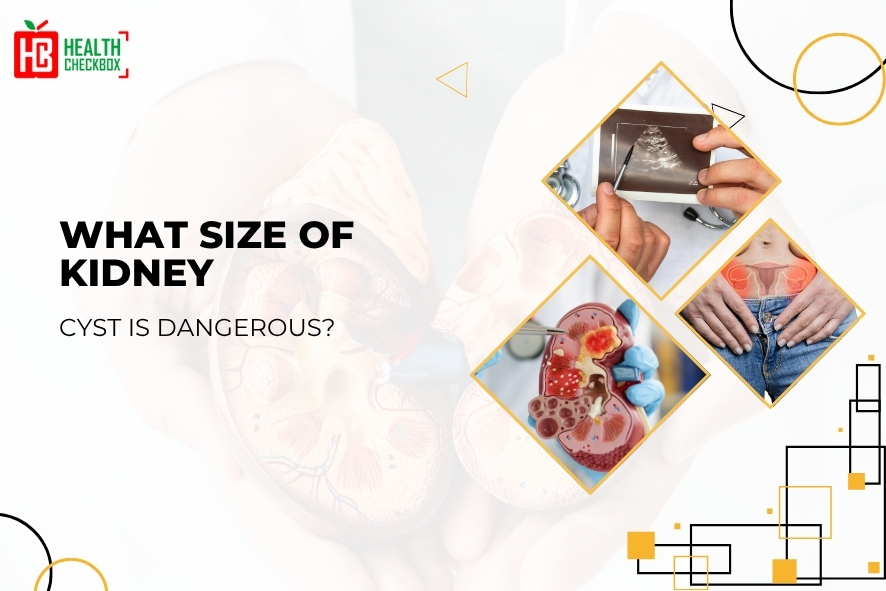A kidney cyst is a tiny fluid pouch. It exists inside the kidney. The bean-shaped kidneys, also known as excretory organs, separate waste products from the body in the form of urine. Kidney cysts are often asymptomatic and non-cancerous. Large cysts, however, can be painful and uncomfortable. Simple renal sacs full of fluid need no medical attention unless they cause symptoms. While some people only have one cyst, others may have multiple cysts. One or more cysts may affect a single excretory organ or both kidneys. When patients come to know about kidney cysts, the thing that comes to their mind is what size of kidney cyst is dangerous? In this blog, we will analyze the size of kidney cysts that is dangerous and look at ways to prevent them.
Usually, kidney cysts are not a reason for concern and hardly have any effect on the function of your kidneys. It is rare to come across a large cyst that can be painful. All your doctor likely wants to do is keep an eye on it and record it in your medical history. When a kidney cyst is suspected your doctor might remove it or suggest more testing.
Types of Kidney Cysts
Simple and complex cysts are the 2 types of kidney cysts. Simple cysts are more common.
- Simple: As individuals age, these are common, and the elderly are more prone to it
- Complex: It is associated with thick walls, solid parts, calcifications, and may need surgical treatment due to potent nature.
When is a Kidney Cyst Size Considered Dangerous?
Normally speaking, the dimension of the cyst aids physicians in deciding whether a cyst requires treatment or follow-up. Larger cysts may call for attention. Especially when these press on surrounding organs, obstruct urine flow or even rupture. However a 6 cm simple cyst with thin walls and clear fluid may be less concerning than a 3 cm cyst with wary features.
Cysts larger than 5 cm (roughly 2 inches) are more likely to cause symptoms or complications though there is no hard cutoff. When a cyst gets this big or bigger many urologists begin to take more notice especially if there are symptoms. Even 3–4 cm cysts however may require monitoring particularly if they appear complicated or are expanding.
Cyst Specifications & Risk Level:
- Small cysts (less than 2 cm): Incidental, low occurrence, and generally no treatment.
- Moderate cysts (2–5 cm): May require monitoring.
- Large cysts (>5 cm): May cause pain, pressure, or complications—often targeted for intervention.
Causes of Renal Cysts
While scientists are unsure of the exact cause, they do know that biological parents do not pass on simple cysts. And illnesses from hereditary diseases do not result in simple cysts. They think that simple kidney cysts could develop as a result of damage or microscopic blockages in the renal tubes. Age and advanced stages of kidney condition have a major role in developing kidney cysts. Below are some major causes:
- Age: A tiny fluid-filled sac, especially in elderly people, is noticeable. The chance of developing these fluid-filled sacs rises with age.
- Chronic Kidney Disease (CKD): Kidney cyst development may be more likely in people with chronic kidney disease (CKD) and other kidney disorders.
- Injury or Trauma: Kidney cysts can occasionally appear following an injury or trauma to the kidneys.
Symptoms of Kidney Cysts
Simple kidney cysts normally do not cause any problems. Only when these are enlarged can it lead to:
- Discomfort or Pain: Kidney cysts that are big can cause discomfort or irritation in the back or side of the kidneys.
- Hematuria: Cysts can induce bleeding when you urinate. This ill-health can produce pink, red, or brown urine.
- High blood pressure: Kidney cysts, mainly big ones, can cause an increase in blood pressure that may lead to hypertension. Managing blood pressure becomes critical to avoiding problems.
- An urgency to urine often: Cysts can increase pressure on the bladder and it may result in frequent urination.
- Sharp pain: An unforeseen, sharp flank pain, it may be due to breakage in the cyst, especially after trauma.
Diagnosis: How Are Cysts Measured?
Typically, healthcare experts employ imaging investigations to evaluate renal cysts which include:
- Ultrasound
- Computed Tomography (CT) Scan
- Magnetic Resonance Imaging (MRI)
Treatment Options for Kidney Cysts
If the size of the kidney cyst is dangerous, what kidney treatment is best for the patient? The doctor may monitor the kidney cysts that are small for a certain time with regular diagnosis. However, if serious symptoms develop, a person may require antibiotics or over-the-counter painkillers. Symptoms may occur if a cyst prevents the movement of urine or blood through the kidneys. To drain the cyst, the doctor may propose:
- Surgery
- Drainage
- Sclerotherapy
Sclerotherapy utilizes ultrasound to guide a needle into the cyst, emptying it, and injecting an alcohol solution to help prevent it from recurring. A healthcare specialist may call for the removal in case of a big cyst. This is normally done in a hospital with general anesthesia. A surgeon may remove the cyst with a small gadget that includes a light and camera on one end. This helps them to keep the incision very modest.
Prevention Tips for Renal Cyst
Removing a simple kidney cyst is not possible. You can avert the risk by:
- Drinking as much water as possible.
- Restraining your sugar and salt levels in the diet.
- Managing chronic health conditions like diabetes and hypertension.
- Going for regular checkups, especially if the condition of cystic kidney disease persists in the family.
Conclusion
Cysts bigger than four to five centimeters, particularly those that cause symptoms or display complex imaging characteristics, require closer monitoring. But length alone does not reveal what size of the renal cyst that is threatening. What matters is how the cyst appears, if it is developing, and whether it causes symptoms or affects kidney function.
If doctors have diagnosed you with a kidney cyst, don’t panic. Most of these cysts are harmless and require no more than the occasional monitoring. Simply stay informed, ask questions, and consult with your healthcare provider to determine the best course of action.

